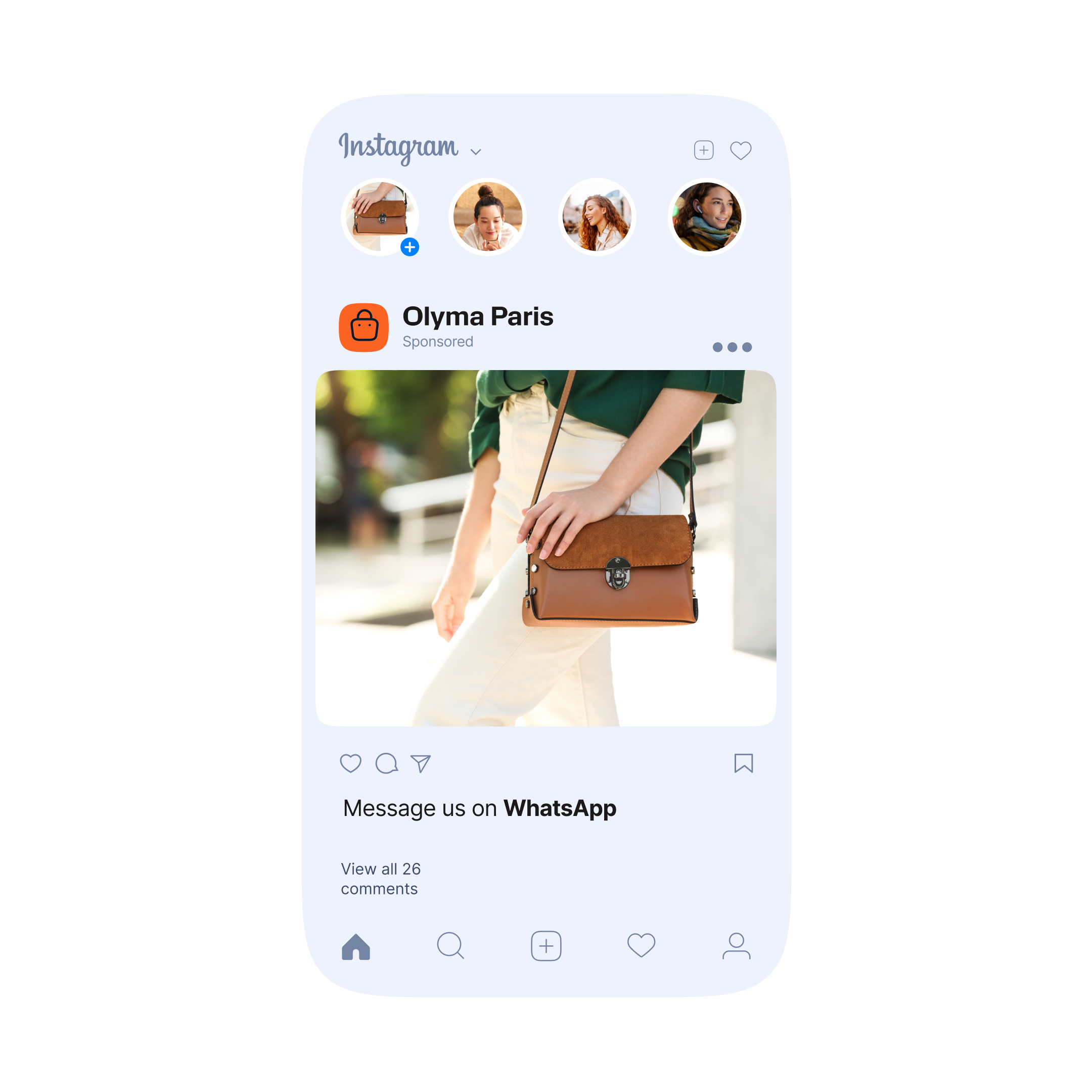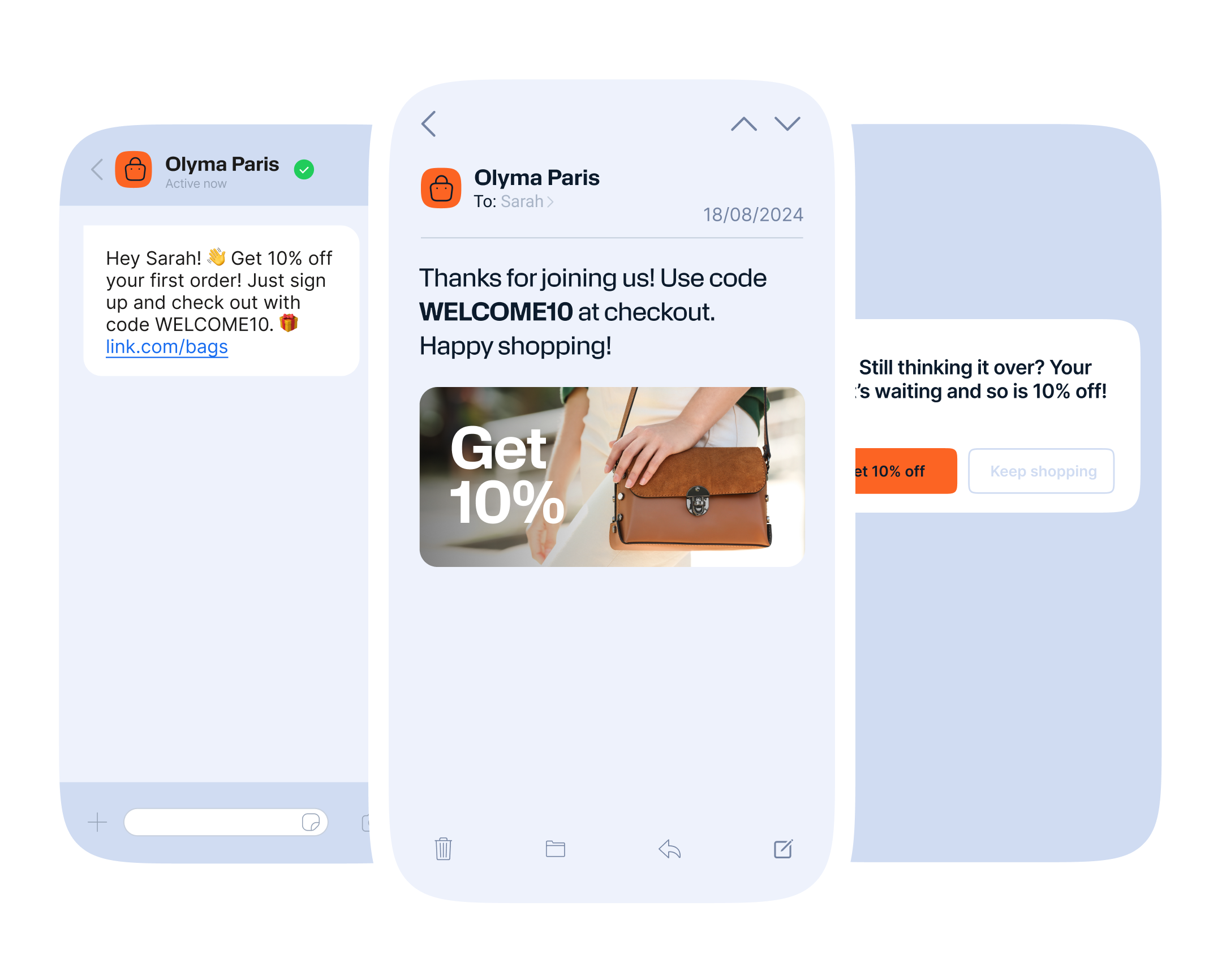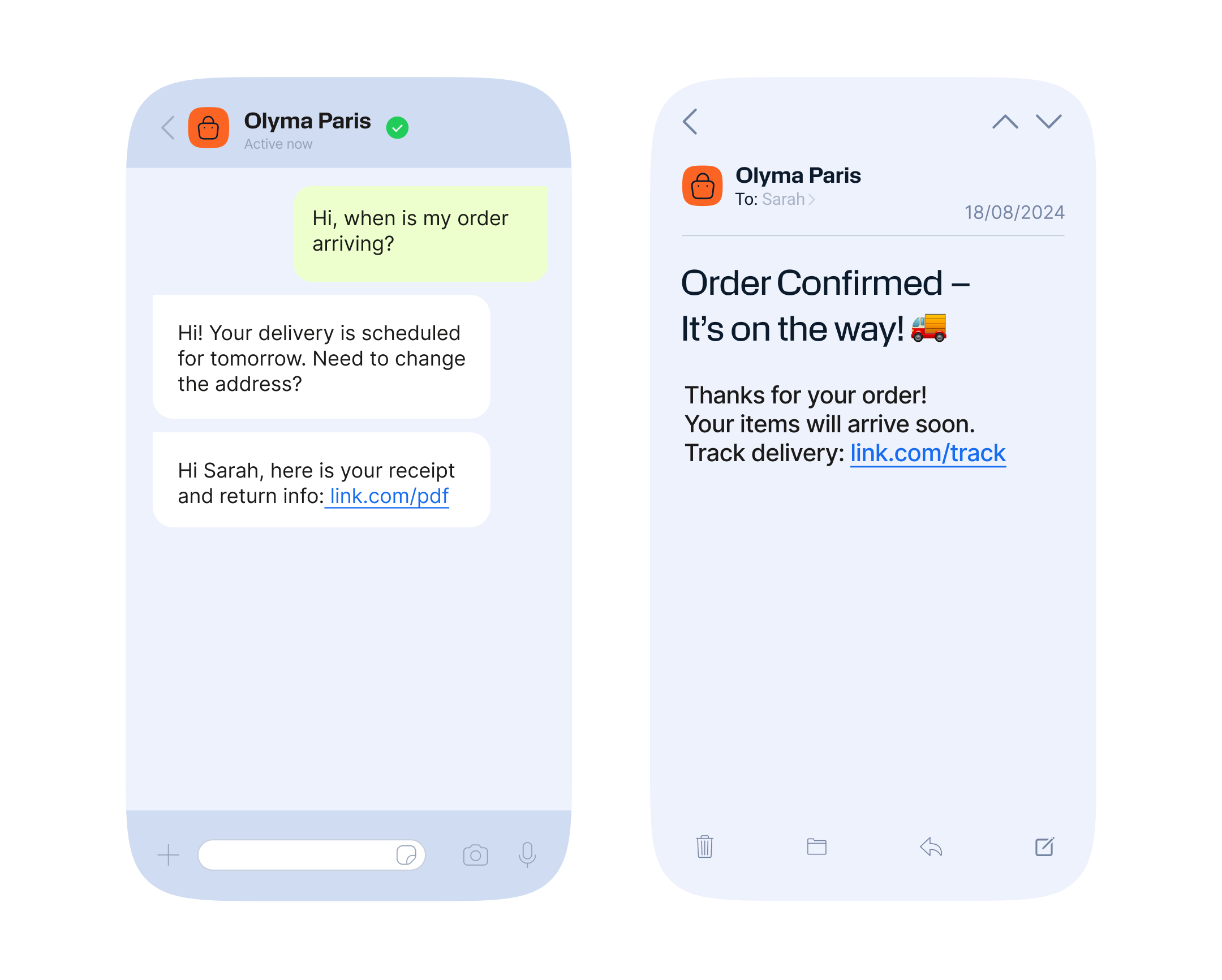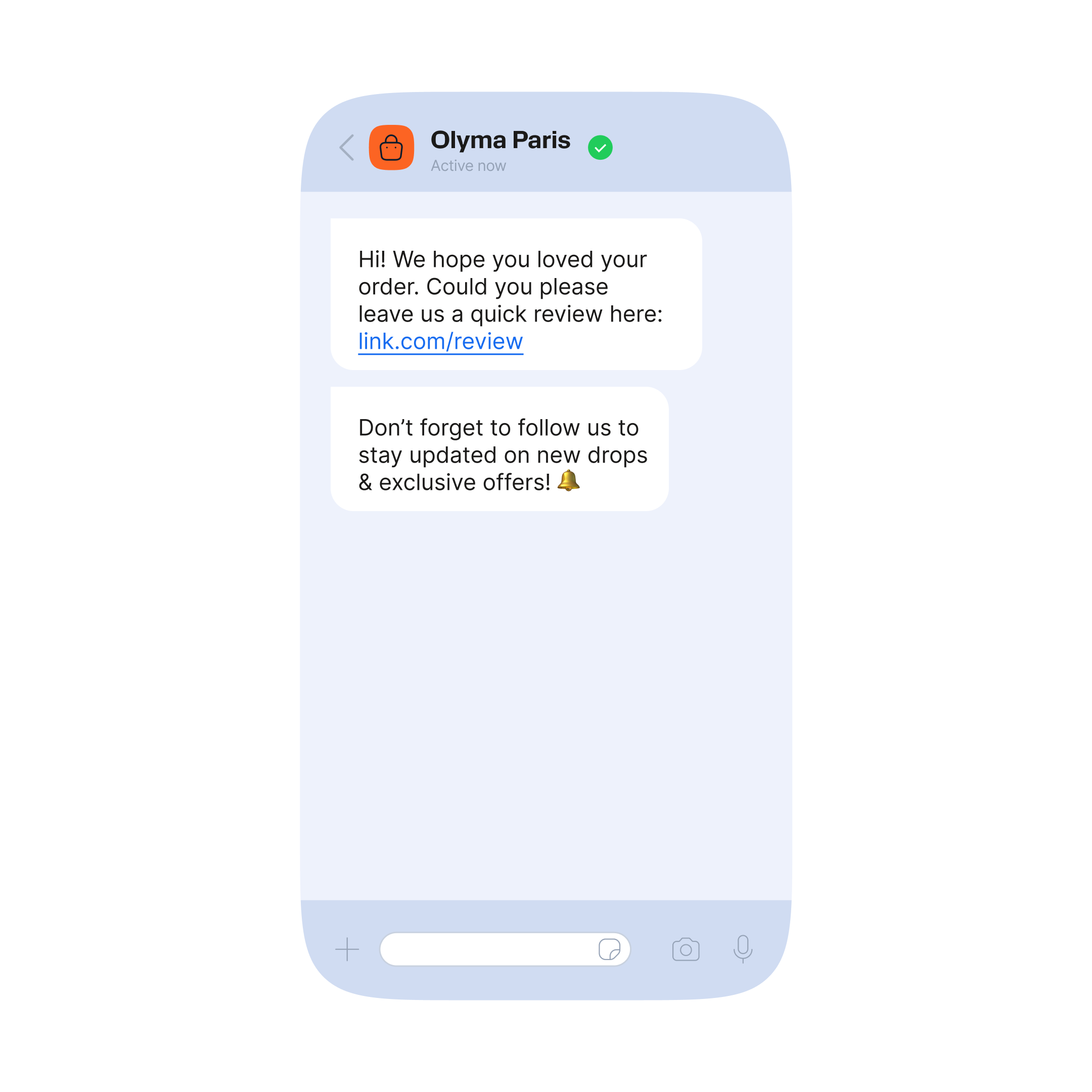Omnichannel retail strategy: Sell smarter across every channel
With the right omnichannel retail strategy, you can personalize every step of the customer journey and create a smoother path to purchase and loyalty. Explore how to make it happen.

To meet rising consumer expectations, businesses need an omnichannel retail strategy that unifies every touchpoint. Shoppers still visit physical stores, but they also want quick, seamless digital experiences on their mobile devices.
According to McKinsey, Gen Z values a seamless experience more than the shopping platform. Also, 92% of Gen Z are more likely to buy from a brand if the message feels personal and relevant.
To stay competitive, retailers need to use omnichannel communication and follow new trends to improve customer engagement in retail. This is where omnichannel retail solutions come in.
What is an omnichannel retail strategy?
An omnichannel retail strategy is a way to connect all your customer touchpoints into one smooth, consistent experience. It lets customers move between channels easily, leading to better service, stronger loyalty, and more sales. All your channels should work together, so customers can switch between them effortlessly.
These channels can include email, voice, and SMS, as well as digital channels, social media, messaging apps, and live chat.
Here are some examples:
- Synchronizing online and in-store inventories
- Offering buy online, pick up in store (BOPIS)
- Using customer relationship management (CRM) tools to track customer interactions across platforms
The goal is to engage with your brand consistently, no matter the platform. For example allowing a customer to start a conversation on Instagram and continue it via WhatsApp without repeating information, improving their overall experience.
The rise of omnichannel usage in retail
We analyzed 530 billion interactions on our platform in 2024 to uncover how customers and brands use omnichannel communications.
Here are the main findings about channel use on our platform for retail and eCommerce brands compared to 2023:
- SMS remains a key channel, for short-form text notifications
- The number of businesses using more than two channels has grown from 15% in 2023 to over 25% in 2024
- 550% increase in the use of RCS for rich media promotional messages, authentication, and two-way conversational support
More retail brands are using multiple channels to run marketing campaigns, build complete customer journeys, and improve experiences. The most popular combination is SMS and RCS.
Single channel, multichannel, and omnichannel retailing
You can tell the difference between the three by looking at the words. But let’s break down the terms, especially focusing on omnichannel vs multichannel strategies.
Single channel retailing: A retailer focuses on selling through only one channel. This could be a traditional brick-and-mortar store, an online website, or direct sales. Single-channel retail is simple to manage and has lower costs. But it has limited reach, and you risk missing out on customers who prefer different channels.
Multichannel retailing: A retailer uses multiple channels, including a physical store, a website, mobile apps, social media, etc. It has increased customer reach and potential for higher sales. However, there can be gaps or differences in the experience across channels.
Omnichannel retailing: It means using many channels, but unlike multichannel, it combines them all into one smooth experience. All the channels are connected, allowing customers to switch between them easily and without disruption.
What omnichannel retail trends are shaping strategies for 2025?
Trend 1: Increase digital engagement
Today, 94% of brands use email, 60% use SMS, and 44% use voice to connect with customers. While these are essential, the first step to truly increasing digital engagement is expanding beyond these channels. To keep up with modern shoppers, use chat tools and social platforms they’re already on.
Gen Z now uses social media to research brands more often than they use search engines. This means that your shoppers want to explore your products, interact with your brand, and make purchases on their social media apps.
Trend 2: Merging online and offline retail
Retail shopping has undergone significant changes in recent years. As customers moved toward online shopping, retailers had to quickly adapt to meet their changing expectations. However, in-store shopping remains relevant and continues to play an important role in the retail experience.
To bridge this gap, many brands are turning to phygital marketing, a strategy that combines physical store experiences with digital tools like mobile apps, QR codes, and social channels to create a smooth, omnichannel journey for customers.
According to the IDC Infobrief, customers prefer a mix of online and in-store buying and return options. More than half (51%) say they’re likely to switch to a competitor if flexible returns aren’t available. Nearly 60% say that the ability to buy online and pick up in-store is important.
Research indicates that 73% of customers engage in omnichannel shopping. They expect smooth communication and service both in-store and online, no matter where they are in their journey.
Trend 3: Automation with the right chatbots
Chatbots are a beneficial tool for retailers to bring better experiences to customers through their omnichannel strategy. Thanks to better chatbot technology, you can now use different types of chatbots that do more than just answer basic FAQs:
- Quick to develop and implement
- For faster customer service, sales support, engagement, and query resolution
- Use conversation design and natural language processing (NLP) to design conversation flows
- For more complex conversations that replicate human-to-human interactions
- Agentic AI chatbots can go a step further by taking initiative-handling tasks, making decisions, and guiding customers proactively across channels
Trend 4: Personalization and the value of customer data
Retailers need to focus on data they collect directly from customer interactions. A Customer Data Platform (CDP) helps you understand each customer and their activity across all touchpoints. With this data, businesses can tailor product recommendations, marketing messages, and promotions to each shopper’s preferences and behavior.
48% of brands find it hard to organize customer data because different teams keep their data separate. For example, marketing and customer service might use different tools without sharing insights and this creates a gap.
To fix this, businesses need a clear, company-wide strategy. When all teams work together and share data, you get a complete view of your customers. This helps you choose the right channels, send better messages, and improve customer engagement.
Depending on the business, they will be in different places, digitally speaking. You can create different customer journeys depending on potential touchpoints. From there, you can make each journey better, more fulfilling, and more valuable for the customer. And in the end, that will set your business apart and create a memorable experience for the customer.
Benefits of an omnichannel strategy
1. Offers an end-to-end shopping journey
An omnichannel approach helps retailers design complete customer journeys, from awareness to post-purchase, across multiple platforms. You can run personalized marketing campaigns, improve customer engagement activities in retail, and create smooth transitions between channels.
2. Simplifies inventory management across all sales channels
By connecting online and offline systems, retailers get better visibility into inventory across all locations. This reduces stockouts and overstock, helping businesses meet customer expectations more efficiently.
3. Improves customer service and provides better customer experience
Customers want fast, easy access to support on any channel they choose. With omnichannel communication, retailers can reduce effort for the customer, provide proactive updates, and respond quickly, boosting satisfaction and loyalty.
4. Unifies data
Retailers can collect and analyze data from every customer interaction, no matter the channel. Unifying data helps remove silos between teams and enables more effective customer engagement strategies across departments.
5. Increases sales
With more touchpoints and consistent messaging, retailers can better guide shoppers toward purchase. Omnichannel strategies support upselling, cross-selling, and re-engagement, driving higher revenue.
6. Personalizes the customer journey
Using real-time customer data, retailers can tailor messages, offers, and experiences to individual preferences. Personalized journeys lead to stronger customer relationships and more meaningful brand interactions.
How to use omnichannel communications in retail
Retailers use omnichannel communication to send back-in-stock alerts, special offers, loyalty rewards, order updates, delivery notifications, and automated answers to common questions.
Here is an example of how a customer can interact with a brand across four channels and have a seamless shopping journey.
Awareness
- A customer sees your Instagram ad for a product that catches their attention.
- You included a click-to-WhatsApp button in your ad, so the customer clicks it to ask about your offer.
- After two days, the customer has not yet made a purchase.

Consideration
- You send a WhatsApp message offering them 10% off their first purchase when they register an account and check out.
- The customer registers and receives a welcome email with the promo code.
- The customer adds items to their cart through your mobile app but doesn’t complete the purchase.
- You send a mobile app push notification to remind them of their abandoned items.

Purchase
- The customer completes the purchase and gets a payment confirmation email.
- After a few days, the customer reaches out to you through WhatsApp, asking when they can expect their delivery.
- An Agentic AI agent quickly answers, confirms delivery for tomorrow, and offers to update delivery details.
- The next day, the customer gets a WhatsApp message with their receipt and return info.

Post-purchase
- After a great experience, retailer asks for a review via WhatsApp.
- The customer leaves a review and follows the brand to stay informed about future promotions.

How to create an omnichannel retail strategy
To meet growing customer expectations, retailers need a smart omnichannel strategy. By using data, preferred channels, and seamless integration, you can boost marketing efforts and offer better brand experiences.
Segment customers
Start by using customer data to build detailed customer profiles. Segment audiences by demographics, behavior, location, social media platforms, and purchase habits. For example, if you’re targeting Gen Z, use TikTok and Instagram. Offer deals like loyalty program rewards or influencer promotions that match their shopping habits.
Discover the right channels
Know which channels your audience actually uses. Use customer preferences to guide your investments. Frequent shoppers might prefer loyalty apps, while occasional buyers respond better to email discounts or targeted ads on social media.
Map the journey
Build journey maps for your top customer segments. Plot each step from awareness to post-purchase and find friction points. For instance, a customer sees an influencer post, clicks the tagged brand, browses your Instagram, and buys through a retargeted ad. A strong omnichannel strategy supports this kind of seamless integration across all touchpoints.
Communicate across channels
Use the best channel for each step: social media for awareness, email to nurture, and live chat or WhatsApp for support. Use online tools to improve in-store visits, like helping staff check stock or answering questions on social media.
Add automation
Support your strategy with automation tools. Use chatbots to answer FAQs or guide shoppers through purchase steps. Transfer to a live agent with all the conversation details when necessary. Platforms like Answers (chatbot building platform) and Moments (customer engagement solution) make it easy to automate flows and CTAs.
Test and improve
Track campaign results by channel; clicks, conversions, satisfaction. Use A/B testing on subject lines, images, and timing to refine your messaging. Optimize regularly to improve ROI and customer engagement.
Retail tools to power your omnichannel strategy
- Chatbot builder: Deploy rule-based or AI chatbots to handle customer support and engagement.
- Customer data platform & marketing automation tool: Collect and unify customer data, then use it to send personalized, automated messages across channels.
- Cloud contact center: Manage customer interactions across channels from a single, integrated platform.
To make these tools truly omnichannel, they need to be integrated and synced with each other and the channels you choose. This seamless connection ensures a smooth, consistent customer journey. For that, you might need support from CX experts who can help you design and implement the right customer journeys for your business.








